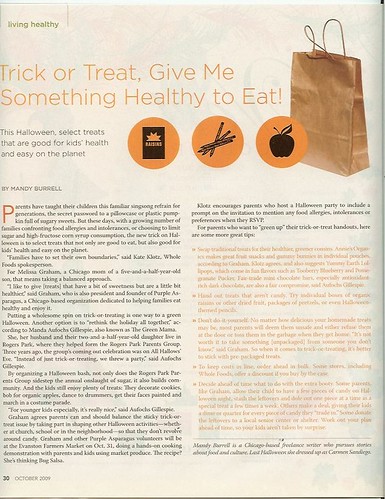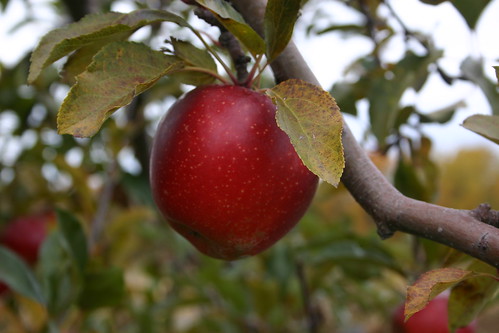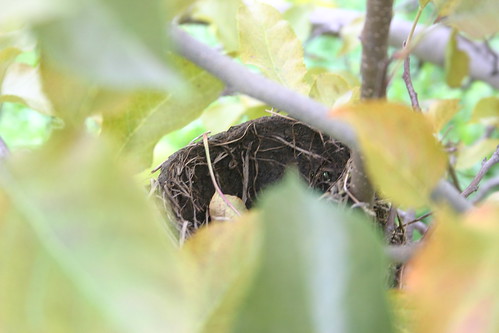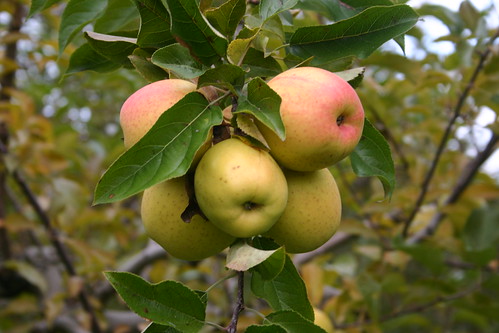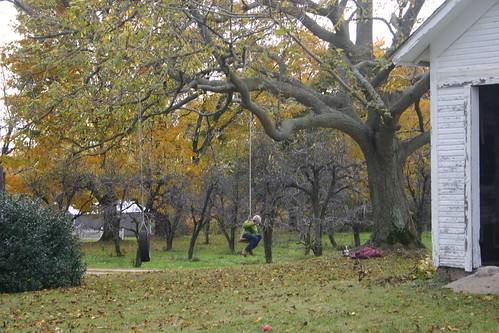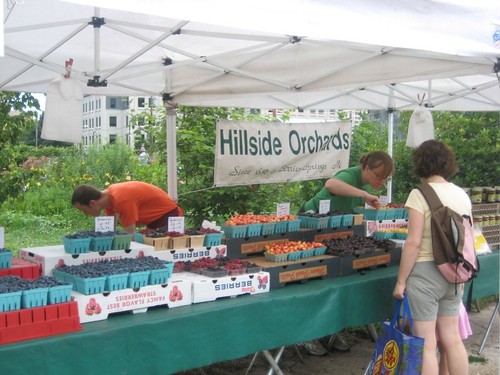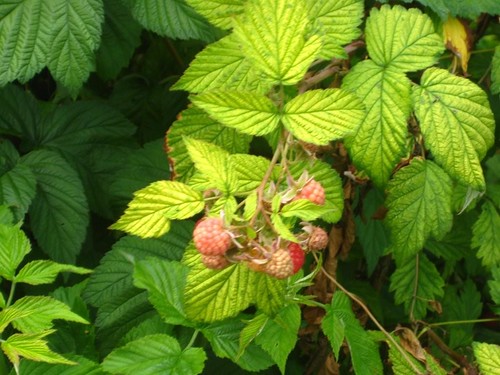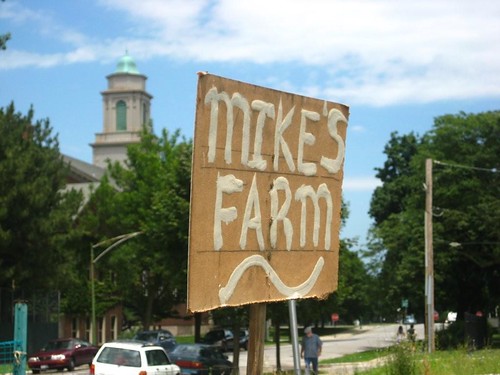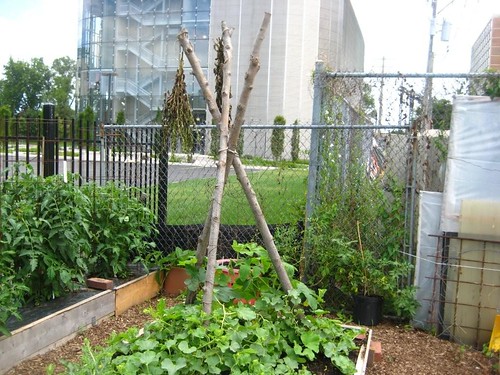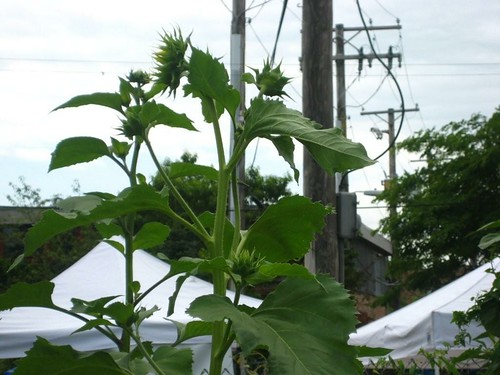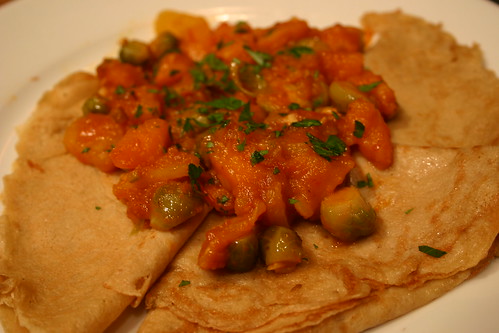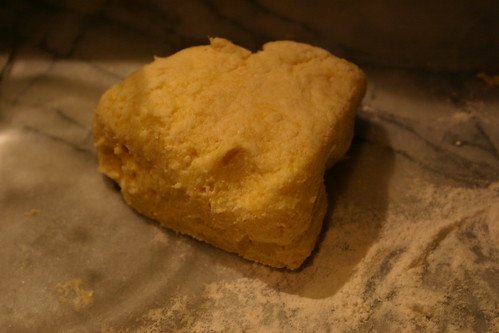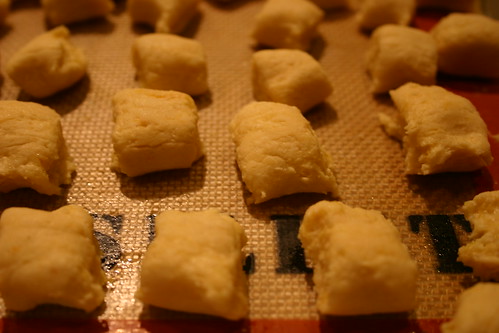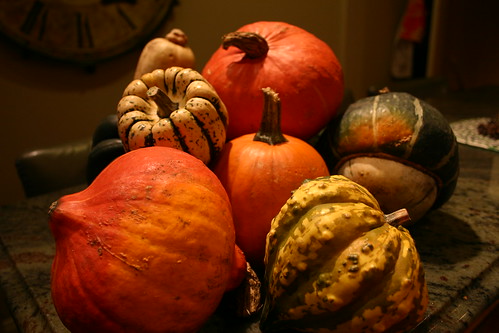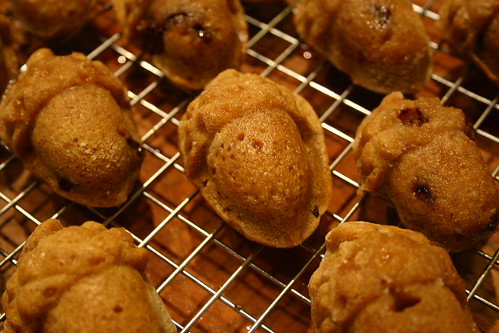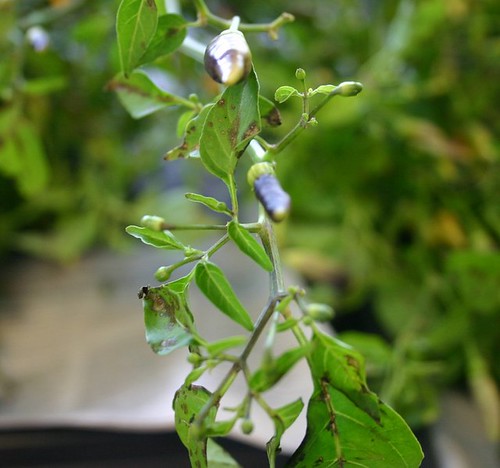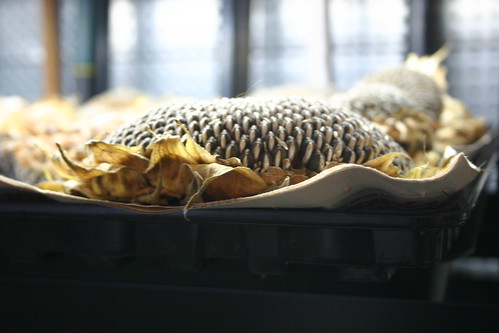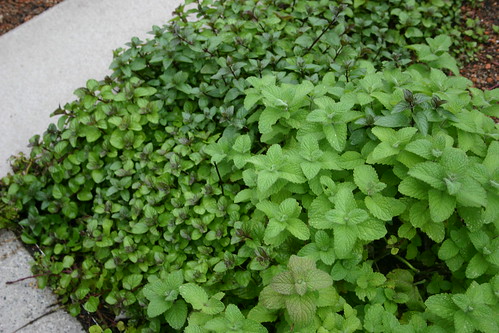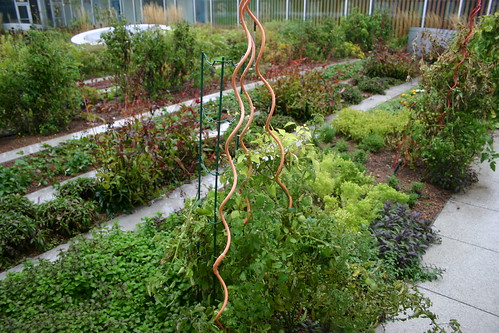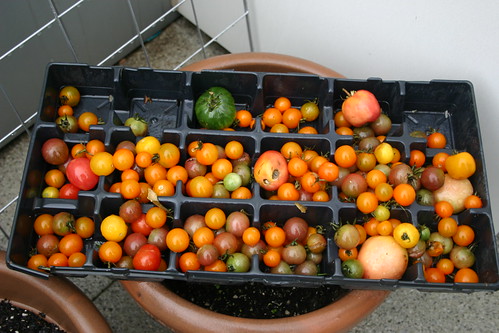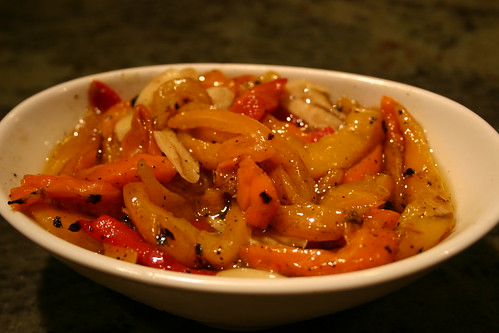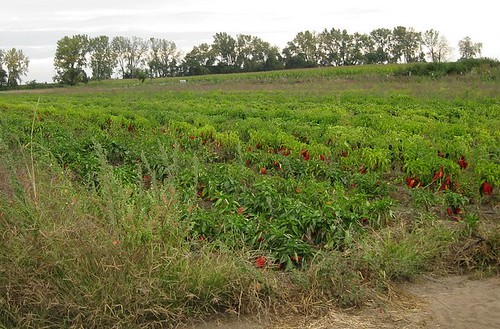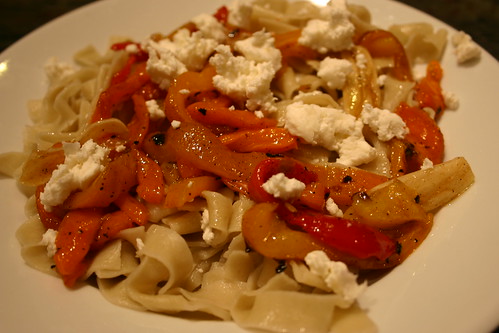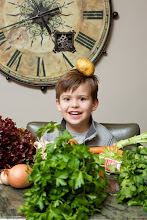 (My grandmother’s plate, a hand-painted ceramic made by a Long Island artist, with the beer stein from which I drank little shots of beer with my German grandfather to wash down our sauerbraten.)
(My grandmother’s plate, a hand-painted ceramic made by a Long Island artist, with the beer stein from which I drank little shots of beer with my German grandfather to wash down our sauerbraten.)As the story goes, I first started cooking when I was four. My mom charged with me planning for and “cooking” dinner once a week. In the beginning, dinner was pretty Spartan – PB&J on Ritz crackers and English muffin pizza, as I have been told. While they’ve never admitted it, I’m quite certain that my parents ordered Chinese when I went to bed.
Despite a fair number of extra-curricular activities, this responsibility carried through elementary school, junior high and even high school. My recollection is that I felt somewhat ambivalent towards my assignment. Obviously, I didn’t hate it, but I don’t seem to remember much of what I cooked, so I must not have loved it either. The strangest happening of the matter was how the chore did ultimately turn to passion.
A few weeks before my high school graduation, I got a case of (oh how shall I put it?) the runs. Turns out that somewhere I had picked up a pretty bad case of salmonella. It’s still a matter of controversy, but the theory is that it came from the mayo dressing on a fast food hamburger. Suffice to say, anything that went in my mouth went out the other end and fast. To make matters worse, our family doctor misdiagnosed me and, in my weak condition, I would up contracting mono.
While my high school buddies were enjoying there last days in our home town, I was convalescing on my couch. Not being much of television watcher, I started with books. After five of the books on my college reading list, I'd had enough. Then puzzles, 1000 piece puzzles – the appeal wore off. Finally, and ironically given my lack of appetite, I started on my mother’s cookbook collection. I poured over the Julia Child, underlined her Craig Claibourne and starved over the Gourmets. This, ironically, is what made me a cook.
The book that inspired this series of posts is the one that went untouched. Dusty and a bit smelly, chartreuse in that kitchenette color in vogue back in the 1960’s, Roy Andries de Groot’s
Feasts for All Seasons remained on the shelf, pushed aside for more modern pleasures. It seemed old-fashioned, certainly nothing that even a starving 18-year old would give a second look to. But this was early in my cookbook obsession.
About halfway into my college junior year, I signed up for the Cookbook of the Month. In my first order, I got Julia Child’s
The Way to Cook and
The New Basics by Julie Rosso and Sheila Lukins. Both still sit on my small kitchen cookbook shelf. I would travel and buy more cookbooks. I worked at the Smithsonian one summer and bought more cookbooks still. Then I began to raid my mother’s collection. By this time, I had begun to read the literary stars of gastronomy: MFK Fisher, Elizabeth David and Brillat-Savarin, which led me to
Recipes from The Auberge of the Flowering Hearth.
Roy Andries de Groot was a British-born American culinary writer, born in London, the son of a Dutch artist and a French noblewoman. During World War II, de Groot was employed by the British Ministry of Information and worked for the BBC, where, during the Blitz of London, he suffered eye injuries that would ultimately leave him completely blind. He moved to New York City where he married a British actress, had two daughters and lived on Bleecker Street in Greenwich Village.
I adored his
Recipes from The Auberge of the Flowering Hearth, the story of how de Groot went to France to seek out the history of the liqueur Chartreuse but instead discovered the world of two Alpine women who owned an inn or auberge where they cooked with the seasons and from the heart. So, of course, when I excavated his
Feasts for All Seasons, I “borrowed” it.
Feasts for All Seasons is a cookbook, a wine guide and an explanation of how to become a gourmet. Most poignantly, however, it is a diary of how a food-loving family lived on a budget in the early 1960s. I could go on for paragraphs, but the feature that I loved best, and found most inspiring, was the family’s celebration of the Feast Days of the World. In the Introduction, de Groot wrote that:
“[t]he second rule of our family gastronomy has been the exploration of the peoples and cultures of foreign nations through foods . . . . At home, while our girls were in school, we thought we might add to their studies on world civilization by celebrating some of the foreign feast days at our own table; with traditional menus, the proper wines, serving customs, often the music of the country and sometimes even a study of the festive costumes. “
The de Groot’s celebrated Chinese New Year, Russian Easter, Bastille Day, and Indian Independence Day.
Starting our own tradition, we enjoyed our first Family Feast Day on Thursday. My mom was in town so in honor of our German family heritage, we celebrated Octoberfest. With a slightly Alsatian twist, we served Soft Pretzels with Mustard, Saurkraut and Sausages and a Black Forest Cake with a twist. With the exception of the baking staples, the meal was sourced from the farmers’ market.
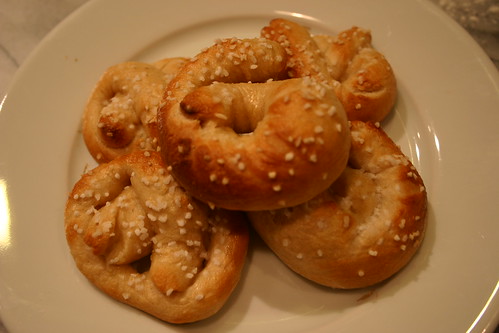
Soft PretzelsMakes 161 cup water
1 ¼-ounce package yeast
½ teaspoon honey
1 tablespoon white wine
¾ cup whole wheat pastry flour
1 ¾ cup unbleached all-purpose flour plus more for rolling out the dough
1 tablespoon vegetable oil
2 teaspoons kosher salt
Pretzel salt
Heat the water in a microwave for approximately 30 seconds until 110° F. Sprinkle yeast on top and add honey, stir to combine. Let the yeast mixture sit for 5 minutes while it foams. In the bowl of stand mixer, mix together yeast, white wine, the flours and oil and salt. Mix with a dough hook until the water is absorbed. Knead with the dough hook for approximately 2 more minutes. Add salt and knead for another minute. Remove from the bowl before the dough is completely smooth and knead by hand for a few minutes or until smooth and elastic, but slightly tacky. Put the dough into a large bowl coated with oil and cover tightly with plastic wrap. Let rise for 1hour.
Preheat the oven to 350° F and bring a large pot of water to a boil.

Cut the dough into 16 pieces. Roll a piece into a eight-inch rope. Shape into a pretzel. Repeat. Boil each pretzel for 1 minute. Set on a baking sheet lined with Silpat or parchment. Sprinkle with pretzel salt and bake until lightly browned, approximately 7 minutes.
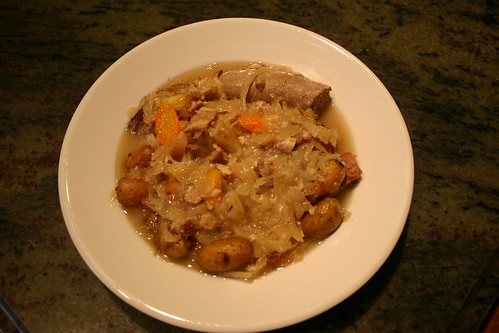
Sauerkraut with Sausages
4 Servings
9 peppercorns
1 clove
5 juniper berries
2 bay leaves
5 coriander seeds
2 sprigs thyme
2 sprigs parsley
2 tablespoons chicken fat or vegetable oil
1 medium onion, thinly sliced
1 large clove garlic, minced
6 small carrots, sliced on the bias about 1-inch thick
4 bratwursts
½ ham steak, thickly sliced
3 slices thick cut bacon, cut into 1-inch pieces
1/3 cup wine
2 cups chicken stock
2 cups sauerkraut
1 pint tiny new potatoes or regular new potatoes, quartered
Tie the first seven ingredients in a small piece of cheesecloth. Heat the chicken fat or oil in a medium Dutch oven over medium heat. Saute the onions until softened, but not browned. Add garlic, carrots, bratwursts, ham slices, and bacon. Pour the wine and stock over the meat. Cover with sauerkraut. Bring the mixture to a simmer. Cover and cook for 1 ½ hour. Uncover and add the potatoes and cook for another ½ hour or until the potatoes are tender.
To honor the passing of a beloved family friend, I made our unconstructed Black Forest Cake using a recipe for chocolate-almond torte from Gourmet Magazine.
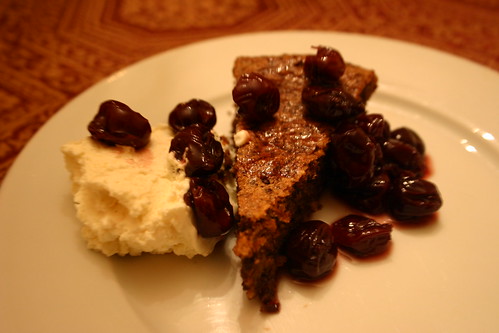
Chocolate Almond Torte
10 servings
4 ounces blanched almonds, lightly toasted and cooled
½ cup granulated sugar
1 ½ sticks unsalted butter, softened
4 large eggs, separated
½ teaspoon finely grated orange zest
1 tablespoon kirsch
6 ounces finely ground bittersweet chocolate.
Preheat the oven to 350º F. Butter the bottom and sides of a 9-inch springform pan. Line the bottom with a parchment circle. Butter the parchment.
Finely grind the almonds with 1 tablespoon sugar until ground fine. Do not let it become a paste.
Cream together the butter and ¼ cup sugar until light. Beat in the egg yolks one at a time. Beat in zest, kirsch and chocolate.
Beat whites in a second bowl until foamy. Add 3 tablespoons and a pinch of salt to the whites while the mixer is on in a gradual stream. Beat until the whites just hold a stick peak. Fold in one third of the whites into the chocolate-almond mixture to lighten. Add remaining whites gently, but thoroughly. Pour batter into the pan, smoothing the top. Bake in the center of the oven for 45-55 minutes or until the cake pulls away from the side of the pan. Cool completely on a rack.
Serve with brandied cherries and whipped cream.
Kids' Cooking TipsJust like I had done when I was little, Thor helped his grandmother with every step of the pretzels. Kids can also help make the cake and whip the cream.
ProvenanceHoney from the City of Chicago Rooftop available at the Downtown Farmstand
Pork from Cedar Valley Sustainable Farm
Carrots from Green Grocer
Onion and new potatoes from Green Acres
Garlic from Growing Home
Sauerkraut from the Downtown Farmstand
Butter from Organic Valley
